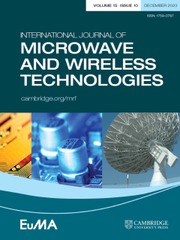Crossref Citations
This article has been cited by the following publications. This list is generated based on data provided by
Crossref.
Agrawal, Neetu
Chouhan, Sanjay
and
Gupta, Manish
2022.
Quad port meander line MIMO antenna with stepped ground structure for 5G wireless application.
p.
1.
Kumar, Anubhav
KumarVerma, Rahul
Saxena, Divya
and
Sharma, Parmanand
2023.
Two-element MIMO Antenna with High isolation based on Zigzag-shaped Slot on the ground for 5G and IOT applications.
p.
232.
Kansal, Parul
Mandpura, Anup Kumar
and
Kumar, Narendra
2024.
Investigation of circularly polarized MIMO antenna with enhanced isolation for sub-6 GHz application.
Physica Scripta,
Vol. 99,
Issue. 10,
p.
105536.
Çelik, Kayhan
2024.
The Novel Monopole Antenna for Sub-6 GHz 5G Applications.
Gazi Üniversitesi Fen Bilimleri Dergisi Part C: Tasarım ve Teknoloji,
Vol. 12,
Issue. 3,
p.
579.
Chouhan, Sanjay
Malviya, Leeladhar
Panda, Debendra Kumar
and
Yadav, Jitendra
2024.
Hexagonal Shaped Antenna Using MIMO Techniques for 2.1 GHz Wireless Application.
Wireless Personal Communications,
Vol. 137,
Issue. 1,
p.
631.
Porwal, Rahul
Garg, Rahul Kumar
Raj, Nikhil
and
Deepak Nair, M. V.
2024.
A Modified Hexagonal Shaped Sub-6 GHz 5G Antenna in MIMO Configuration.
p.
1.
Addepalli, Tathababu
Nagaraju, V. Siva
Medasani, Sivasubramanyam
Rao, Jetti Chandrasekhar
Badugu, Prasanthi
Kumar, Ch. Manohar
Uppada, Rajyalakshmi
and
Kumar, Bandi Kiran
2024.
Four‐element equilateral triangular‐shaped MIMO antenna with connected ground for 5G sub:6 GHz N79 and WiFi‐6E band applications.
International Journal of Communication Systems,
Vol. 37,
Issue. 16,
Chouhan, Sanjay
Malviya, Leeladhar
and
Panda, Debendra Kumar
2024.
Mathematically inspired MIMO antenna with enhanced isolation for wireless applications.
International Journal of Communication Systems,
Vol. 37,
Issue. 7,
V, Asokan
L, Karthika
Selvakumar, Blessy Sharon Gem Johnson
D, Suresh
E, Prabhu.A.
and
R, Meenakshiaishwarya.
2024.
Design of a Highly Isolated Compact Quad Port Orthogonal MIMO Antenna with DGS for C and X band Applications.
p.
1.
Jetti, Chandrasekhar Rao
Sameer, Shaik
Lakshmi, Kancherla Ajita
Devana, V. N. Koteswara Rao
Sirisha, Varikallu
and
Manikanta, Neelam
2025.
Cognitive Computing and Cyber Physical Systems.
Vol. 597,
Issue. ,
p.
384.
V, Asokan
N, Kumaran
S, Sasikala
R, Meenakshi Aishwarya
S.T, PranavaPriya
and
S, Priyavarshini
2025.
Reduction of Mutual Coupling with Highly Isolated Four Port MIMO Antenna Using DGS for 5G Applications.
p.
110.
Addepalli, Tathababu
Medasani, Sivasubramanyam
Rani, Ch Jyotsna
Jetti, Chandrasekhar Rao
Kumar, Bandi Kiran
Kumar, Ch Manohar
Uppada, Rajyalakshmi
and
Badugu, Prasanthi
2025.
Four-Element MIMO Diversity Antenna for 5G Sub-6 GHz N79 Band Applications and Verified with TCM Analysis.
Wireless Personal Communications,
Vol. 140,
Issue. 3-4,
p.
1167.
Addepalli, Tathababu
Kumar, G. Naveen
Rani, Ch Jyotsna
Koppala, Neelima
Jetti, Chandrasekhar Rao
Kumar, Ch Manohar
Uppada, Rajyalakshmi
and
Kumar, Bandi Kiran
2025.
A defected substrate 4-element mimo antenna with higher diversity characteristics for 5G sub 6 GHz N77/N78 band applications.
Wireless Networks,
Vol. 31,
Issue. 2,
p.
1931.
Agrawal, Neetu
and
Chouhan, Sanjay
2025.
Design development and signal processing of 5g mimo antenna on two distinct substrates.
Facta universitatis - series: Electronics and Energetics,
Vol. 38,
Issue. 3,
p.
513.
Arokiya Snowvi, J.
Uma Devi, M.
Atchaya, R.
and
Balamurugan, C.
2025.
Proceedings of International Conference on Computational Intelligence.
p.
561.
Patel, Arpita
Upadhyaya, Trushit
Girjashankar, Pandey Rajat
Swati, M. V.
and
Kumar, Om Prakash
2025.
Enhanced isolation in aperture fed dielectric resonator MIMO antennas for 5G Sub 6 GHz applications.
Scientific Reports,
Vol. 15,
Issue. 1,
Miao, Youming
He, Lei
and
Liu, Gui
2025.
A Miniaturized Eight-Port MIMO Antenna for 5G Ultra-Slim Smartphones.
Electronics,
Vol. 14,
Issue. 3,
p.
566.


